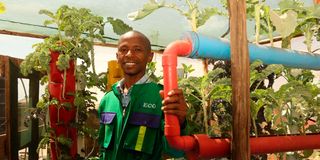Hydroponics: The future of urban crop production

Daniel Wanderi, the founder of Eco-Hydroponics Gardens in Makongeni estate, Thika, on the Garissa road.
What is a hydroponic garden?
This is a controlled environment agriculture system that combines technology with farming. It uses soilless medium, which can be installed on rooftops, balconies and even perimeter walls. We use a growing medium known as pumice. One does not have to worry about soil diseases.
Spinach, collard greens (sukuma wiki) and lettuce do well in this kind of set-up as they have shallow roots.
What are the basic requirements for setting up a hydroponic farming system?
One needs drip irrigation for that is the main component of this system. It is installed with growing media inside, nutrients and seedlings, depending on the variety of crop one wants to produce. Space is also important.
We make tower gardens using PVC pipes, which are perforated and shaped. The holes are made by heating.
We then design an appropriate stand to ensure the garden fits on a balcony.
Vertical gardens are customised for walls, depending on the length and the number of layers to achieve a particular population of plants.
One tower garden is 5ft tall, with a capacity of 48 plants. A 1mx1m space can have four tower gardens, translating to 192 plants per square metre. A vertical garden has a capacity of 80 plants per square metre.
Why should city and town dwellers adopt this kind of farming?
We need to think about urban communities that solely depend on food produced in distant lands.
Let us also take into consideration the empty spaces in Nairobi alone in terms of rooftops, perimeter walls, balconies and others that can be converted to small vertical farms
Hydroponic is a cost-effective farming model as it does not require weeding. There are virtually no costs for preparing land.
This kind of farming uses up to 80 per cent less water than conventional food producing methods, meaning it can be practised in places with little water or during dry seasons.
There is no manual watering as every tower or vertical garden comes with a drip, saving time too.
It saves a lot of space since the gardens are vertical. A 1mx1m space can have up to four tower gardens and 192 plants.
Like I said before, hydroponic farming requires no soil. We use the growing medium.
The PVC piping makes hydroponic gardening durable. It lasts for many years.
Hydroponic gardening is actually climate-smart and gives the farmer the opportunity to grow and produce crops all year round.
We can even customise hydroponics to a particular colour theme. Eventually there is aesthetic value and food.
Who are your clients?
Most of our clients are urban households conscious about their health.
We also install the systems in schools for the Competence Based Curriculum or CBC.
Has Eco-Hydroponics Gardens faced any challenges?
Like any innovator and entrepreneur, it started as an idea. In most cases, the idea comes when one does not have any resources. We struggled to set up the enterprise.
Most consumers want food whose production was free of pesticides. Unfortunately, they are not aware of hydroponic farming.
What important lessons have you learnt?
Innovation can improve food production. Young people can create opportunities for themselves through innovation and technology.
Hydroponic farming is cost-effective and profitable as it uses little water and no soil.
It is an alternative for people with limited or no gardening space and skills for it can be indoors or out.





